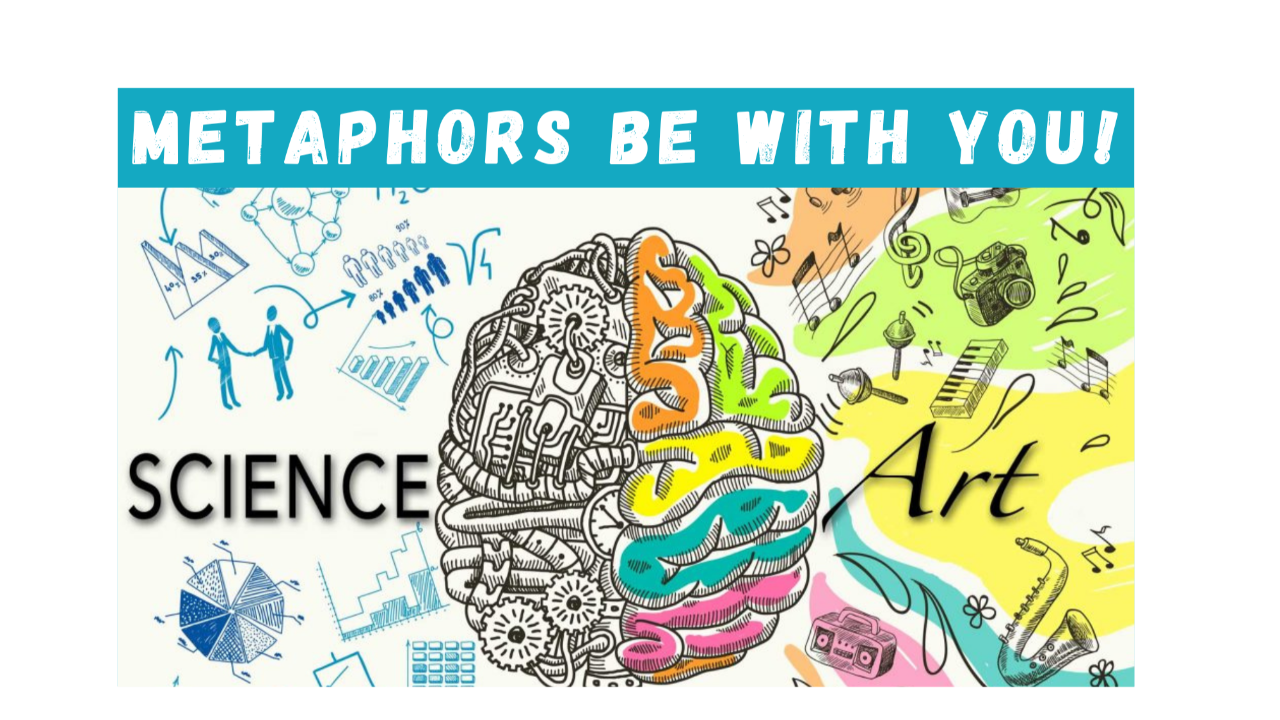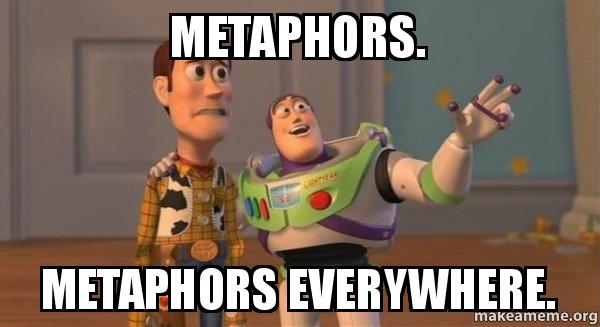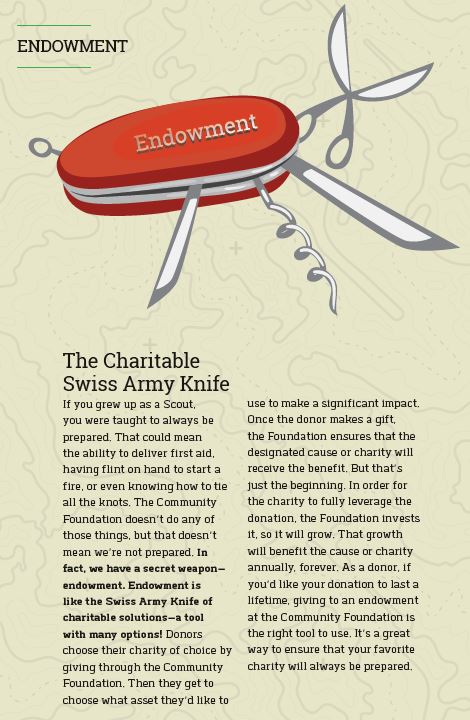Metaphors Be With You
May 03, 2023
As a Junior in High School, I vividly remember one specific day in Mr. Fessenden’s English class. I was sitting on the south side of the classroom in the fourth seat from the front. He always started us out with a free writing exercise to get our ideas flowing. Then he’d call on one of us to share what we’d written. While I can’t remember exactly what I wrote or why I wrote it, I do remember using the word ‘severed’ in my journal entry. He was wowed. He went on and on about how the use of words helped paint pictures, like an artist. And he explained that by using the word severed I had painted a vivid picture in the heads of all who heard my story. He went on to say that the great writers of all time practiced this technique to make it easier for their audiences to understand and remember the stories that they told.
This is a picture of me the year I fell in love with writing and my future husband, Jerry.

That was it; I was hooked. That’s when I fell in love with words and writing. I knew that day that I’d do it my entire life. Fast forward two years later, that was when I entered college and I realized what a tremendous teacher Mr. Fessenden was and how well he had prepared me for all the writing I’d do in college. I’m still so grateful for his investment in me and for sharing his love of language with me; what a gift! I wish he were alive to read this blog; I think he’d be proud to know that he inspired a lifelong writer.
Then, a mere four years later, I was blessed with the opportunity to teach children to read and begin their journey with the written word. I taught using the Writing Process: Pre-writing, Drafting, Revising, Editing, and Publishing. Passing along my love of writing to 6-year-olds was a joy. I especially loved it when they would begin Revising and would wear their special (re)Visors—it was easy to visibly see who was about to Publish their final piece. And it wasn’t long before several of my first graders were writing at a fourth-grade level. They, too, began painting pictures with their words and it was remarkable! That’s the thing about writing, it’s both a science and an art. It's also the thing about loving what you do; it shows!

Left Brain Marketing Methods: The same is true for communicating with your donors. The left brain science of giving and philanthropy must be at the base of all you’re doing. Tools and terms are a mandatory part of explaining what and how to give. But they’re meaningless if your donors don’t understand the tools and terms like you do.
Right Brain Marketing Moxie: That’s why you need to keep your donors engaged through text they understand. When you paint pictures with your words, your donors can see themselves as a character in your story. You NEED them to be a main character in your nonprofit story. The science of giving won’t get them fully there, you need the art, too.

This whole marriage of the art and science of writing is why I love the use of metaphors in the writing we do for our donors. Metaphors remind me of teaching a lot. And whether you think you are or not, you are a teacher: A teacher of philanthropy. That’s right. You’re the expert in your nonprofit’s mission and you know the most effective ways that your donors can give to make a difference for them, the recipients you serve, and your nonprofit. But the fact of the matter is, your donors don’t automatically know how to do this on their own—you need to teach them.
So, when you boil it down to basics, what is the job of a teacher? It doesn’t matter if it was the teacher who taught you to read or the teacher who taught me to write, the most successful teachers all do one thing well—they take complex concepts and simplify them. They break the big ideas into small, bite-sized nuggets that can be easily digested. Those small nuggets are like the segments in a paint-by-numbers canvas that slowly, but surely, becomes art.

Every big idea ever learned started with small building blocks. When you begin to educate the donor at whatever level they may understand you currently, they’ll build the knowledge they need to act. Once they understand how they play a main character in your story about philanthropy, they could change a community, a state, a nation, or a world.
Metaphors do the same thing in writing. They make complex concepts simple and even some controversial ideas more palatable. Additionally, metaphors can even give deep meaning to some concepts that may, initially, seem boring since they can compare two things that are similar in order to explain or entertain—or both.
I like to say that metaphors give people a hook to hang things on since they can easily make the unknown known, the abstract concrete, and the dry stuff more fascinating. Ultimately, if you believe you’re introducing a concept to your donors that is unknown to them, grab a metaphor. If you think a giving tool your donor needs to use is abstract, use a metaphor. If you realize that a philanthropic concept could be a bit boring, make a metaphor your friend.
Do you know that movie where Renee Zellweger says, ‘You had me at hello”? Well, if you want your donor to keep reading past the salutation, you may need to sever the unknown, abstract, and boring from your text. Metaphors be with you!

I love the field of philanthropy as much as the next nonprofit marketer, but I also realize that CRATs, CRUTs, IRA’s, the Pension Protection Act, Charitable Gift Annuities, RMD’s, wills, estate plans, and the like aren’t always the sexiest of topics. But they are all necessary tools in our philanthropic toolbelt. So, we must take these complex concepts and simplify them so they are so easy to understand that our donors can take appropriate action.
Take endowment, for example. You get it. I get it. But even the most generous of people don’t automatically get it. Most nonprofits aren’t in the endowment business like community foundations are. So, we must take that abstract concept and explain it in simple terms they understand so well that they want to give. Metaphors can help you do this!

Check out all the different metaphors, below my signature, that we’ve used in the past as hooks to hang the abstract concept of endowment on. Not only did we paint pictures with our words, but we used examples that they were already familiar with to describe something they weren’t so familiar with—if they understand one concept, they can easily understand the unknown concept. Besides that, it mixes things up. You can only explain the idea of endowment in the same words year after year before you and your donors get bored. That message can become tired and donors might quit reading. Give them a story. Simply the complex. And, yes, I realize this is being published the day before May 4th, but I couldn’t resist: Metaphors be with you!
All My Best,
Dawn
[email protected]
dawn brown creative, llc.
P.S. Fundraising is hard, even though you make it look
oh-so easy! ♥
Frideas--Friday ideas are filled with
info and inspo!
Want to participate in some Knowledge Generosity,
here's your opportunity!
What do you do with an idea? You change the world!
Stay connected with news and updates!
Join my mailing list to receive the latest news, updates, and ideas for days!
Don't worry, your information will not be shared.
I seriously hate SPAM, like for real.
So, I promise to never sell your information, for any reason.







